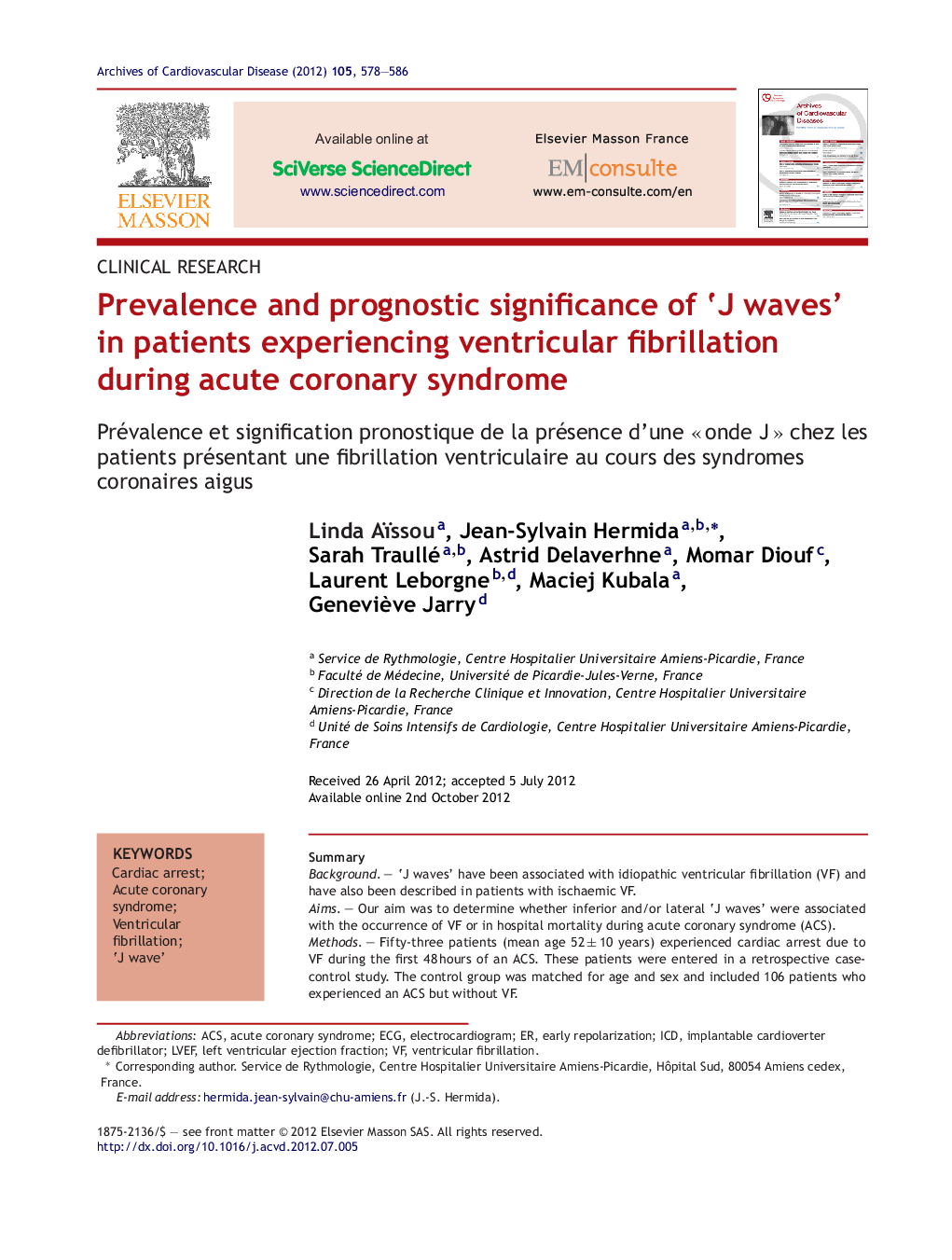| کد مقاله | کد نشریه | سال انتشار | مقاله انگلیسی | نسخه تمام متن |
|---|---|---|---|---|
| 2889485 | 1574370 | 2012 | 9 صفحه PDF | دانلود رایگان |

SummaryBackground‘J waves’ have been associated with idiopathic ventricular fibrillation (VF) and have also been described in patients with ischaemic VF.AimsOur aim was to determine whether inferior and/or lateral ‘J waves’ were associated with the occurrence of VF or in hospital mortality during acute coronary syndrome (ACS).MethodsFifty-three patients (mean age 52 ± 10 years) experienced cardiac arrest due to VF during the first 48 hours of an ACS. These patients were entered in a retrospective case-control study. The control group was matched for age and sex and included 106 patients who experienced an ACS but without VF.Results‘J waves’ were more frequent in the study group than in the control group (62% vs. 39%; P = 0.006). ‘J waves’ (odds ratio [OR] 3.3, 95% confidence interval [CI] 1.5–7.1; P = 0.001) and left ventricular ejection fraction < 40% (53% vs. 14%; P < 0.001) (OR 7.9, 95% CI 3.5–18.0; P = 0.001) were associated with VF. Inhospital mortality was 15.1% in the study group versus 0.9% in the control group (OR 18.7, 95% CI 2.2–157.5; P = 0.008). VF (OR 18.3, 95% CI 2.3–835.9; P < 0.001) and the presence of ‘J waves’ (OR 15.9. 95% CI 2.4–∞; P < 0.001) were predictive of inhospital mortality. In patients who experienced VF, inhospital mortality was 24% when ‘J waves’ were observed and 0% when ‘J waves’ were absent (P = 0.02).ConclusionsInferior and lateral ‘J waves’ were observed more frequently in patients who experienced cardiac arrest due to VF associated with ACS than in the absence of cardiac arrest and were associated with higher inhospital mortality.
RésuméContexteLa présence des « ondes J » est associée aux fibrillations ventriculaires (FV) idiopathiques mais est également décrite chez les patients ayant eu une FV ischémique.ObjectifsLe but de cette étude a été de déterminer si l’existence d’« ondes J » dans les dérivations latérales et/ou inférieures de l’ECG étaient associée au cours des syndromes coronariens aigus (SCA) à la survenue d’une FV ou à la mortalité hospitalière.MéthodesCinquante-trois patients (âge moyen = 52 ± 10 ans) ayant présenté un arrêt cardiaque dû à une FV lors des 48 premières heures d’un SCA, ont été inclus dans une étude cas-témoin rétrospective. Le groupe témoin a été apparié pour l’âge et le sexe. Il comprend 106 patients qui ont eu un SCA mais sans arrêt cardiaque par FV.RésultatsLes « ondes J » ont été plus fréquentes dans le groupe FV que dans le groupe témoin sans FV (62 % vs 39 % ; p = 0,006). La présence d’« ondes J » (OR 3,3, CI 1,5–7,1 ; p = 0,001) et d’une FEVG < 40 % (53 % vs 14 % ; p < 0,001) (OR 7,9, CI 3,5–18,0 ; p = 0,001) sont apparues associées à la survenue d’une FV. La mortalité hospitalière a été de 15,1 % dans le groupe FV contre 0,9 % dans le groupe témoin (OR 18,7, CI 2,2–157,5 ; p = 0,008). La survenue d’une FV (OR 18,3, CI 2,3–835,9 ; p < 0,001) et la présence d’« ondes J » (OR 15,9 CI 2,4–∞ ; p < 0,001) ont été prédictives de la mortalité hospitalière. Chez les patients ayant eu une FV, la mortalité hospitalière a été de 24 % en présence d’une « onde J » et nulle en l’absence d’« onde J » (p = 0,02).ConclusionsAu cours des 48 premières heures d’un SCA, des « ondes J » en position latérales et ou inférieures ont été observées plus fréquemment chez les patients ayant eu une FV et sont apparues associées à une mortalité hospitalière plus élevée.
Journal: Archives of Cardiovascular Diseases - Volume 105, Issue 11, November 2012, Pages 578–586